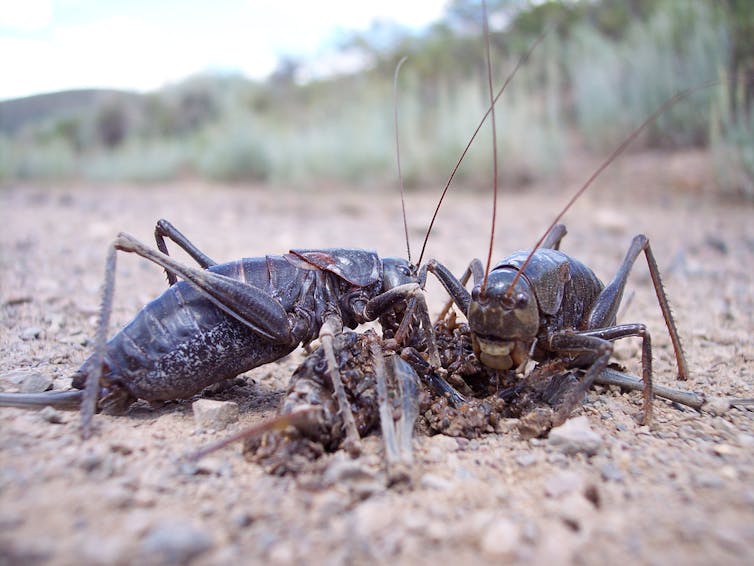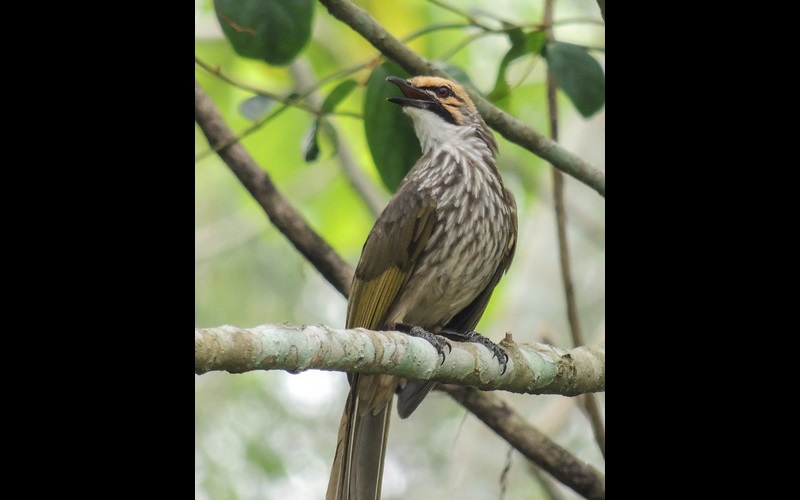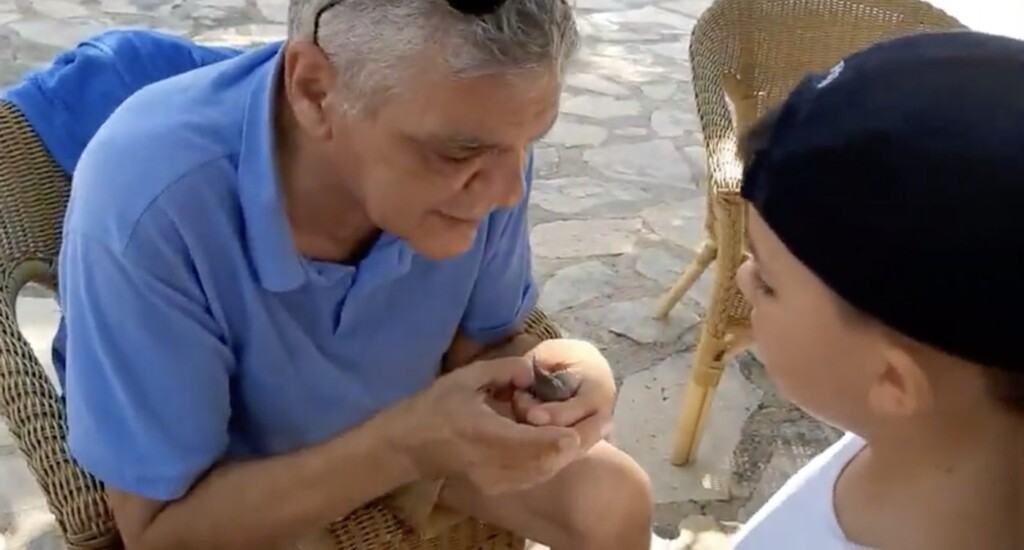.jpg?ext=.jpg)
China starts mass production of carbon-14 isotope
.jpg?ext=.jpg)
Is the bird flu virus inching closer to humans?

Parkinson’s disease: Why it is striking people under 50

Anand Mahindra praises IIT-Madras startup for developing electric flying taxi

Curious Kids: What happens when you flush a toilet on a plane?
 AirP72/Shutterstock
Doug Drury, CQUniversity Australia
AirP72/Shutterstock
Doug Drury, CQUniversity AustraliaWhat happens when you flush a toilet on a plane? –Lily, aged 6, Harcourt
Lily this is a great question! It doesn’t work like your toilet at home, which uses gravity to remove waste from our toilets into the sewer system. An aeroplane toilet uses a vacuum system along with a blue chemical that cleans and removes odours every time you flush.
A smelly tank
The waste and blue cleaning fluid ends up in a storage tank under the floor, in the very back of the cargo hold of the aeroplane. With so many people on the plane using the toilets, you can imagine how big the storage tank is!
The system is designed very much like the vacuum cleaners we use around the house to remove dirt and dust from our floors. This dirt and dust ends up in a container that we empty into a garbage bin. Similarly, the aeroplane’s toilets need the vacuum pressure system to move all the waste from the toilet into the plumbing pipe that connects the toilet to the storage tank, and finally into the tank.
There is a valve on the storage tank that opens when a toilet is flushed and closes when the toilet is not in use – to prevent odours from leaving the tank. This helps to keep the smell down from so many people using the toilet during a flight. The blue chemical helps to keep the smell down as well.
Where does it go once the plane lands?
A special truck comes to the aircraft after it lands and connects a hose to remove the waste and blue cleaning chemical into a storage tank on the truck. The truck plugs a hose into the airplane’s waste tank valve and removes all of the waste into the tank on the back of the truck.
The truck then takes the waste to a special area at the airport reserved for the waste from all aeroplanes, and the toilet waste is emptied into the sewer system for that airport. The training to operate the truck takes three days.
 Various trucks and vehicles will service the plane, load fuel, load cargo and take away waste at the airport. aappp/Shutterstock
Various trucks and vehicles will service the plane, load fuel, load cargo and take away waste at the airport. aappp/ShutterstockWatch out for blue ice
It has also been reported that sometimes, particularly on older planes, the valve where the waste truck connects to the aeroplane can leak a small amount of the waste and blue chemical. This turns to ice as the temperature at normal cruising altitude of 30,000 feet is normally around -56°C and the chemical turns to “blue ice”. This blue ice remains attached to the plane as long as the temperature remains below freezing.
Once the aeroplane begins to descend to land at the destination airport, the blue ice begins to thaw and may even fall off. There have been several occasions reported in the news where people have witnessed this flying poo!
In case you were wondering, the captain of the plane doesn’t have a button to release the waste from the storage tank while the plane is flying. Any waste that might leak out of the plane would be totally accidental.
Some people do think aeroplane contrails (the white lines planes sometimes leave in the sky) are either a special mind-control chemical or toilet waste. This is not true! What you are actually seeing are water vapours coming from the engine becoming ice crystals – like a thin cloud in the sky.![]()
Doug Drury, Professor/Head of Aviation, CQUniversity Australia
This article is republished from The Conversation under a Creative Commons license. Read the original article.
Nuclear's role in reaching climate targets recognised by G7
.jpg?ext=.jpg) The meeting of the G7 ministers (Image: G7 Italia)
The meeting of the G7 ministers (Image: G7 Italia)UK and New Zealand partner for subsea cable earthquake

If size and frequency count, crickets may be the sexiest creatures

Susan Lawler, La Trobe University: If you had to guess what creature in the world had the largest testes, I doubt you would guess that the prize belonged to a cricket.
The testes of the tuberous bush cricket (Platycleis affinis) are an internal affair, taking up most of the cricket’s abdomen. At nearly 14% of their body weight, they are disproportionately large when compared to other species. Just think, a 100kg human would be walking around with 14kg of testicles, which would be mighty uncomfortable.
Why do these crickets need all that sperm power? It is because their females are highly promiscuous. The male bush crickets do not release more sperm than normal in any given sexual act, but they can be called upon to do it so often they apparently need the reserves. In the world of insects, it is not worth missing an opportunity, and if the females are going to be all available like that, then a cricket needs some world-class balls.
But this is not the only sexual record held by crickets. An Australian species known as scaly crickets (Ornebius aperta) have the most frequent sex of any species in the world. These little guys can do it more than 50 times in a few hours, often with the same female!
Why do they have to keep this up? Because she eats it.
That’s right, cricket sex provides more than the spark for the next generation. Males actually produce a package called a spermatophore, which is sperm wrapped up in a nutritious protein package. When the males insert it into a special opening in the females, sometimes she just bends down to gobble up her yummy post-coital snack.
Australian spiny cricket males respond to this sabotage by releasing only a few sperm per package, between 5 and 225 sperm per copulation, an astonishingly low amount compared to the average (100,000). Yet when researchers measured sperm loads in females, they had up to 20,000 sperm stored away. This means that they had sex up to 200 times to collect that amount.
Of course the females were storing up more than sperm. They also gathered nutrients that will help them develop eggs for the next generation. Other species of crickets manage the situation by offering a courtship gift in the form of food from the dorsal glands that distract the female and give her something to eat during sex.
Some female crickets seek out males in order to get these tasty gifts. A study of 32 different species of bushcrickets showed that the larger the spermatophore, the more likely the females were to actively seek out males. These gifts are costly to produce, so species that produce small spermatophores may mate twice a night, while those with large spermatophores may mate only once or twice in a lifetime.
The final cricket sex record goes to the Mormon cricket, which produces a spermatophore that is 27% of its body weight. That’s a huge investment in wild oats, which is a good description, since most of the package is food. The Mormon crickets are flightless and form swarms similar to locusts. These great walking hordes are often so hungry that cannibalism is common.
Female Mormon crickets will compete for males just so they can get a feed, and the benefit for the male is that some of his sperm may make it to the next generation.
Crickets are not likely to be overly loyal to each other, because research on Spanish field crickets shows that individuals with more mating partners leave more offspring. This applies to both male and female crickets, so it is surprising that males will nevertheless protect a female that they have mated with.
Male crickets will linger near a female they have recently given their sperm to, not to scare away other suitors, but to protect the female from predators. He does this at his own peril, because males that hang about after sex are four times more likely to be eaten. On the other hand, the females are six times less likely to be eaten if he is there to protect her.
Male crickets are not confused about the goal of spermatophore transfer. But female crickets want more than just sperm from their partner. A meal (or several dozen meals) increases the male cricket’s chance of getting lucky.
Maybe they are not so different from people, after all. ![]()
Susan Lawler, Head of Department, Department of Environmental Management & Ecology, La Trobe University
This article is republished from The Conversation under a Creative Commons license. Read the original article.
Cuteness Overload as Seal Walks into New Zealand Hardware Store
 credit – Bunnings, released
credit – Bunnings, released credit – Bunnings, released
credit – Bunnings, releasedTwo Big Cats from Infamous Tiger King Captivity Thriving in San Diego After Sanctuary Helps Save 69 Tigers

University of Delaware professor wins top bio-innovation prize
Incredible 60% of Europe’s Electricity Was Powered by Clean Energy in the First Two Months of 2024

North America to witness rare astronomical phenomenon – total solar eclipse

How Singapore Became an Unexpected Stronghold for a Critically Endangered Bird
 Straw-headed bulbul – credit Michael MK Khor CC 2.0. Flickr
Straw-headed bulbul – credit Michael MK Khor CC 2.0. FlickrWitness the Glory of the 2024 European Tree of the Year – Growing in Poland for 200 Years
 credit – Marcin Kopij
credit – Marcin KopijAI is creating fake legal cases and making its way into real courtrooms, with disastrous results
 Shutterstock Michael Legg, UNSW Sydney and Vicki McNamara, UNSW Sydney
Shutterstock Michael Legg, UNSW Sydney and Vicki McNamara, UNSW Sydney
We’ve seen deepfake, explicit images of celebrities, created by artificial intelligence (AI). AI has also played a hand in creating music, driverless race cars and spreading misinformation, among other things.
It’s hardly surprising, then, that AI also has a strong impact on our legal systems.
It’s well known that courts must decide disputes based on the law, which is presented by lawyers to the court as part of a client’s case. It’s therefore highly concerning that fake law, invented by AI, is being used in legal disputes.
Not only does this pose issues of legality and ethics, it also threatens to undermine faith and trust in global legal systems.
How do fake laws come about?
There is little doubt that generative AI is a powerful tool with transformative potential for society, including many aspects of the legal system. But its use comes with responsibilities and risks.
Lawyers are trained to carefully apply professional knowledge and experience, and are generally not big risk-takers. However, some unwary lawyers (and self-represented litigants) have been caught out by artificial intelligence.
 Generative AI tools, like ChatGPT, can provide incorrect information. Shutterstock
Generative AI tools, like ChatGPT, can provide incorrect information. ShutterstockAI models are trained on massive data sets. When prompted by a user, they can create new content (both text and audiovisual).
Although content generated this way can look very convincing, it can also be inaccurate. This is the result of the AI model attempting to “fill in the gaps” when its training data is inadequate or flawed, and is commonly referred to as “hallucination”.
In some contexts, generative AI hallucination is not a problem. Indeed, it can be seen as an example of creativity.
But if AI hallucinated or created inaccurate content that is then used in legal processes, that’s a problem – particularly when combined with time pressures on lawyers and a lack of access to legal services for many.
This potent combination can result in carelessness and shortcuts in legal research and document preparation, potentially creating reputational issues for the legal profession and a lack of public trust in the administration of justice.
It’s happening already
The best known generative AI “fake case” is the 2023 US case Mata v Avianca, in which lawyers submitted a brief containing fake extracts and case citations to a New York court. The brief was researched using ChatGPT.
The lawyers, unaware that ChatGPT can hallucinate, failed to check that the cases actually existed. The consequences were disastrous. Once the error was uncovered, the court dismissed their client’s case, sanctioned the lawyers for acting in bad faith, fined them and their firm, and exposed their actions to public scrutiny.
Despite adverse publicity, other fake case examples continue to surface. Michael Cohen, Donald Trump’s former lawyer, gave his own lawyer cases generated by Google Bard, another generative AI chatbot. He believed they were real (they were not) and that his lawyer would fact check them (he did not). His lawyer included the cases in a brief filed with the US Federal Court.
Fake cases have also surfaced in recent matters in Canada and the United Kingdom.
If this trend goes unchecked, how can we ensure that the careless use of generative AI does not undermine the public’s trust in the legal system? Consistent failures by lawyers to exercise due care when using these tools has the potential to mislead and congest the courts, harm clients’ interests, and generally undermine the rule of law.
What’s being done about it?
Around the world, legal regulators and courts have responded in various ways.
Several US state bars and courts have issued guidance, opinions or orders on generative AI use, ranging from responsible adoption to an outright ban.
Law societies in the UK and British Columbia, and the courts of New Zealand, have also developed guidelines.
In Australia, the NSW Bar Association has a generative AI guide for barristers. The Law Society of NSW and the Law Institute of Victoria have released articles on responsible use in line with solicitors’ conduct rules.
Many lawyers and judges, like the public, will have some understanding of generative AI and can recognise both its limits and benefits. But there are others who may not be as aware. Guidance undoubtedly helps.
But a mandatory approach is needed. Lawyers who use generative AI tools cannot treat it as a substitute for exercising their own judgement and diligence, and must check the accuracy and reliability of the information they receive.
In Australia, courts should adopt practice notes or rules that set out expectations when generative AI is used in litigation. Court rules can also guide self-represented litigants, and would communicate to the public that our courts are aware of the problem and are addressing it.
The legal profession could also adopt formal guidance to promote the responsible use of AI by lawyers. At the very least, technology competence should become a requirement of lawyers’ continuing legal education in Australia.
Setting clear requirements for the responsible and ethical use of generative AI by lawyers in Australia will encourage appropriate adoption and shore up public confidence in our lawyers, our courts, and the overall administration of justice in this country.![]()
Michael Legg, Professor of Law, UNSW Sydney and Vicki McNamara, Senior Research Associate, Centre for the Future of the Legal Profession, UNSW Sydney
This article is republished from The Conversation under a Creative Commons license. Read the original article.
Man Ignores Naysayers to Revive Tiny Sparrow with CPR – Watch the Moment his Patience is Rewarded
 Submitted by Costakis Constantinou: In a heartwarming video, a 67-year-old actor from Cyprus became determined to use his CPR expertise to save a tiny, helpless sparrow. The avian creature was found unconsciousness following an “unfortunate pool mishap”. In the background of the video, you can hear a chorus of teasing and snickering, with voices urging him to dispose of the seemingly lifeless bird—but Costakis Constantinou remained undeterred. “Nobody thought this was possible or even worth trying,he however, stayed focus and patiently continued,” his son Rolandos told GNN. With unwavering determination, he persistently, applied his life-saving skills until, against all odds, the sparrow gradually regained consciousness, fluttering back to life. “I can say with confidence that he was very, very happy, relieved, and satisfied when the little sparrow open its eyes and flied away.” When Rolandos rewatched the video again (see below), he got emotional and telephoned his dad to tell him how proud he was. “In the past he saved two people from heart attack by applying CPR. For some reason my father is at the right place the right time.” “I wanted to surprise him by sending over his video,” said Rolandos in an email. “I’m so proud of him.”Watch the moment his patience was rewarded…Man Ignores Naysayers to Revive Tiny Sparrow with CPR – Watch the Moment his Patience is Rewarded:
Submitted by Costakis Constantinou: In a heartwarming video, a 67-year-old actor from Cyprus became determined to use his CPR expertise to save a tiny, helpless sparrow. The avian creature was found unconsciousness following an “unfortunate pool mishap”. In the background of the video, you can hear a chorus of teasing and snickering, with voices urging him to dispose of the seemingly lifeless bird—but Costakis Constantinou remained undeterred. “Nobody thought this was possible or even worth trying,he however, stayed focus and patiently continued,” his son Rolandos told GNN. With unwavering determination, he persistently, applied his life-saving skills until, against all odds, the sparrow gradually regained consciousness, fluttering back to life. “I can say with confidence that he was very, very happy, relieved, and satisfied when the little sparrow open its eyes and flied away.” When Rolandos rewatched the video again (see below), he got emotional and telephoned his dad to tell him how proud he was. “In the past he saved two people from heart attack by applying CPR. For some reason my father is at the right place the right time.” “I wanted to surprise him by sending over his video,” said Rolandos in an email. “I’m so proud of him.”Watch the moment his patience was rewarded…Man Ignores Naysayers to Revive Tiny Sparrow with CPR – Watch the Moment his Patience is Rewarded:Atlanta Science Festival returns to inspire discovery for all ages
Cultivated Biosciences secures US$5 million seed funding amid US market launch in 2025
Why does a leap year have 366 days?
 Leap Day is coming. Marvin Samuel Tolentino Pineda/iStock, via Getty images
Leap Day is coming. Marvin Samuel Tolentino Pineda/iStock, via Getty imagesAfter four years, those leftover hours add up to a whole day. In a leap year, we add this extra day to the month of February, making it 29 days long instead of the usual 28.
The idea of an annual catch-up dates back to ancient Rome, where people had a calendar with 355 days instead of 365 because it was based on cycles and phases of the Moon. They noticed that their calendar was getting out of sync with the seasons, so they began adding an extra month, which they called Mercedonius, every two years to catch up with the missing days.
In the year 45 B.C.E., Roman emperor Julius Caesar introduced a solar calendar, based on one developed in Egypt. Every four years, February received an extra day to keep the calendar in line with the Earth’s journey around the Sun. In honor of Caesar, this system is still known as the Julian calendar.
But that wasn’t the last tweak. As time went on, people realized that the Earth’s journey wasn’t exactly 365.25 days – it actually took 365.24219 days, which is about 11 minutes less. So adding a whole day every four years was actually a little more correction than was needed.
In 1582, Pope Gregory XIII signed an order that made a small adjustment. There would still be a leap year every four years, except in “century” years – years divisible by 100, like 1700 or 2100 – unless they were also divisible by 400. It might sound a bit like a puzzle, but this adjustment made the calendar even more accurate – and from that point on, it was known as the Gregorian calendar.
What if we didn’t have leap years?
If the calendar didn’t make that small correction every four years, it would gradually fall out of alignment with the seasons. Over centuries, this could lead to the solstices and equinoxes occurring at different times than expected. Winter weather might develop in what the calendar showed as summer, and farmers could become confused about when to plant their seeds.
Other calendars around the world have their own ways of keeping time. The Jewish calendar, which is regulated by both the Moon and the Sun, is like a big puzzle with a 19-year cycle. Every now and then, it adds a leap month to make sure that special celebrations happen at just the right time.
The Islamic calendar is even more unusual. It follows the phases of the Moon and doesn’t add extra days. Since a lunar year is only about 355 days long, key dates on the Islamic calendar move 10 to 11 days earlier each year on the solar calendar.
For example, Ramadan, the Islamic month of fasting, falls in the ninth month of the Islamic calendar. In 2024, it will run from March 11 to April 9; in 2025, it will occur from March 1-29; and in 2026, it will be celebrated from Feb. 18 to March 19.
Learning from the planets
Astronomy originated as a way to make sense of our daily lives, linking the events around us to celestial phenomena. The concept of leap years exemplifies how, from early ages, humans found order in conditions that seemed chaotic.
Simple, unsophisticated but effective tools, born from creative ideas of ancient astronomers and visionaries, provided the first glimpses into understanding the nature that envelops us. Some ancient methods, such as astrometry and lists of astronomical objects, persist even today, revealing the timeless essence of our quest to understand nature.
 Ancient Egyptians were dedicated astronomers. This section from the ceiling of the tomb of Senenmut, a high court official in Egypt, was drawn sometime circa 1479–1458 B.C.E. It shows constellations, protective gods and 24 segmented wheels for the hours of the day and the months of the year. NebMaatRa/Wikimedia, CC BY
Ancient Egyptians were dedicated astronomers. This section from the ceiling of the tomb of Senenmut, a high court official in Egypt, was drawn sometime circa 1479–1458 B.C.E. It shows constellations, protective gods and 24 segmented wheels for the hours of the day and the months of the year. NebMaatRa/Wikimedia, CC BYPeople who do research in physics and astronomy, the field that I study, are inherently curious about the workings of the universe and our origins. This work is exciting, and also extremely humbling; it constantly shows that in the grand scheme, our lives occupy a mere second in the vast expanse of space and time – even in leap years when we add that extra day.
Hello, curious kids! Do you have a question you’d like an expert to answer? Ask an adult to send your question to CuriousKidsUS@theconversation.com. Please tell us your name, age and the city where you live.
And since curiosity has no age limit – adults, let us know what you’re wondering, too. We won’t be able to answer every question, but we will do our best.![]()
Bhagya Subrayan, PhD Student in Physics and Astronomy, Purdue University
This article is republished from The Conversation under a Creative Commons license. Read the original article.




